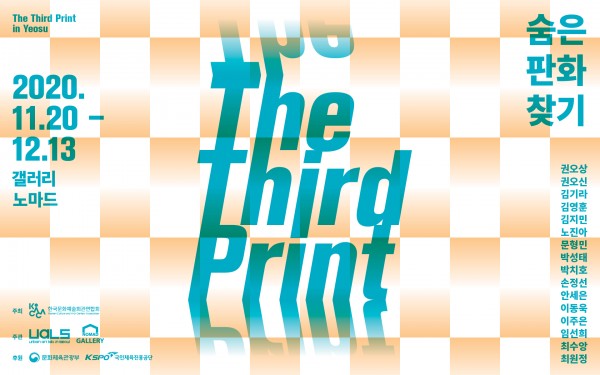갤러리탭1 The Third Print in Yeosu: Finding hidden print 숨은판화찾기
페이지 정보

본문
| 작품명 | The Third Print in Yeosu: Finding hidden print 숨은판화찾기 |
|---|---|
| 사이즈 | 2020.11.20(FRI) – 12.17(THU) |
| 재료 | 평일 10:00 –18:00 토일요일 10:00 – 15:00 |
| 특징 | 월요일휴관 |
| 기타1 | 기획 |
| 기타2 | 권오상, 권오신, 김기라, 김영훈, 김지민, 노진아, 문형민, 박성태, 박치호, 손정선, 안세은 |
| 기타3 | GWON Osang, KWON Ohshin, KIM Kira, KIM Younghoon, KIM Jimin, ROH Jinah, MOON Hyungmin, PARK Sungtae, PARK Chiho, SON Jeongseon, AN Seeun, LEE Dongwook, LEE Jueun, LIM Sunhee,CHOI Xooang,CHOI Wonjung |
| 기타4 | |
| 기타5 | |
| 기타6 |
제품설명
The Third Print in Yeosu: Finding hidden print 숨은판화찾기
2020.11.20(FRI) – 12.17(THU)
전시서문
판화는 일반적으로 그림, 글씨 등으로 새긴 판을 이용하여 종이에 인쇄하는 시각 예술 기법과 그 결과 만들어진 작품을 의미한다. 모노타이핑(Monotyping)과 같은 특별한 경우를 제외하면 여러번 인쇄하여 복제가 가능하다. 인쇄된 각각의 작품은 회화의 작품과 달리 쇄(刷)라 불리며 다른 장르에 비해 특히 매체적인 특성을 고수함과 동시에 다양한 판의 기법을 통해
“찍어내는” 판화의 고유영역을 지켜왔다.
한편, 문화적 성장과 테크놀로지의 발달로 인하여 예술에도 변화가 생겼다. 장르와 영역의 구분이 모호해지고, 특히 테크놀로지의 발달은 판화의 재료와 기법에 많은 영향을 미쳤다. 많은 작가들이 판화기법을 이용해서 독창적인 작품을 만들고, 판화만을 고집하고 에디션을 중시하였던 많은 판화가들이 새로운 기법과 방법들을 응용해 본인의 방식으로 1장의 판화를 찍어낸다. 과거의 모노타이프라는 장르가 하나의 트렌드로서 Monotypes, Collotypes, Cast prints, Gum printing, Cliche Verre, Blueprints, Brown Sepiaprints, Embossed Lead Imges, Cast Plate Intaglio (Printmaking:History and Process by Donal Saff and Deli Sacilotto책에서 발췌) 등의 다양한 방식으로 표현되었다면, 현재의 작가들과 판화가들은
또 다른 새로운 방식 (The Third Print)의 모노타이프를 통해 판화의 정체성을 내포한 더 넓은 영역으로의 가능성을 보여주고 있는 것이다.
첫 전시 ‹The Third Print›는 기존의 판화가 가지고 있었던 ‘에디션’이라는 전통에서 벗어난 모노프린트, 판화를 주매개로 하지 않은 작가들의 프린트 작업이라는 발상을 통해 새로운 전시방안을 모색했었다.
두 번째 ‹The Third Print : 호모아키비스트›는 ‘기록‘ 이라는 관점에서 작가들의 아카이빙 데이터를 기반으로 한 작업들을 제안, 작가들의 주관적 수집을 통한 확장된 프린트의 개념으로 판화전시를 조금더 구체화하여 제안하였고, 작가들만의 고유한 방식의 아카이빙을 통해 다양한 모노타입의 판화를 표현할 수 있었고, 실험적이고, 다양한 방식의 판화들이 소개되었다.
이번전시 ‹The Third Print인 여수: 숨은판화찾기›는 판화의 정체성을 포함한 더 넓은 영역으로서의 가능성을 실험하는 자리로서 작가들이 작품 속에 숨겨놓은 판화를 찾아냄과 동시에 작품 안의 다양한 ‘쾌‘를 찾을 수 있을 것이라 기대한다. 사실 예술작품은 너무 다양하기 때문에 그것들을 제공하는 ’쾌‘역시 꼭 어떤 ‘즐거움’을 의미한다기 보다 예술작품을 통한
일종의 ’카타르시스‘를 경험하게 되는 순간을 의미하는 것이 더 적절하다.
어떤 작품은 비통하게 하거나 멜랑콜리하게 하기도 하고, 또 어떤 작품들은 열광적인 기분을 만들어내기도 한다. 두려움과 경탄, 유쾌함과 흥분, 웃음과 슬픔의 눈물, 공포와 노여움 등등 우리의 감성(emotion)과 지성을 끌어들일 수 있는 판화의 새로운 플랫폼으로서의 역할을 할 수 있기를 기대한다.
이승아
LEE Seungah
Printmaking generally refers to the visual art technique of printing on paper, using plates on which pictures or texts are engraved and works produced by the technique. Unlike paintings, prints can be duplicated multiple times, except for special types like monotypes, and those duplications are called ‘editions.’ Printmaking has unique characteristics coming from the mediums and techniques as compared to other technical applications and the various methods of using ‘plates and prints’ can be considered unique ways of ‘printing.’
Recent trends and contemporary concerns in art have changed, and the distinctions between art genres and forms have become blurred. Technology also affected the materials and methods of printmaking in many ways. Artists who have been insisting only on traditional printmaking techniques and emphasizing on editions started to apply new techniques and methods to their own style and create unique or singular prints.
The first exhibition The Third Print explored a new exhibition through the idea of a monoprint that deviated from the tradition of ‘edition’ that the conventional prints had, and the print work of the artists who have not used print as their main medium. The second exhibition, The Third Print: Homo Archivist proposed works based on the archived data of the artists from the perspective of ‘record’ and a more concrete print exhibition with the concept of an expanded print through their subjective collection. Through the archiving of their own method, various prints in monotypes could be expressed, and prints with experimental and various methods were introduced.
The Third Print in Yeosu: Finding Hidden Prints is a place to experiment with the possibilities of a wider area beyond the identity of print, and audiences are expected to find various ‘pleasures (kwae)’ in the works by finding prints hidden by the artists in them. In fact, works of art are so diverse that the ‘pleasure’ provided by them is more appropriate to mean the moment when you experience a kind of ‘catharsis’ through a work of art, rather than a particular ‘pleasure.’ Some works can be heartbreaking or melancholy, while others can create a passionate mood. We hope that this exhibition will serve as a new platform for prints that can attract our emotions and intellects, such as fear and wonder, joy and excitement, tears of laughter and sadness, fright and anger.
< 체험 프로그램 >
1. 프로그램 명: DIY 무빙인쇄소 (주강사-이주은, 보조강사-손정선)
2. 진행 계획: 오프닝 1회 + 전시기간 내 매주 토요일 총 4회
(총 5번의 체험프로그램 / 총 50 여명 참여)
3. 갤러리노마드
4. 참여인원: 각 회수별로 8명-14명 참여.
- 2020. 11. 20. (금) 오후 3-5시 / 주강사 1인 보조강사 1인
- 2020. 11. 21. (토) 오전 10-12시 / 주강사 1인 보조강사 1인
- 2020. 11. 28. (토) 오전 10-12시 / 주강사 1인 보조강사 1인
- 2020. 12. 05. (토) 오전 10-12시 / 주강사 1인 보조강사 1인
- 2020. 12. 12. (토) 오전 10-12시 / 주강사 1인 보조강사 1인
< 도슨트 프로그램 >
1. 프로그램 명: The Third Print 인 여수: 숨은판화찾기 / 총 8회의 도슨트
2. 진행 계획: 오프닝 1회 (큐레이터 도슨트 프로그램) - (1회)
- 아티스트 도슨트 프로그램 / 오전 10:00-12:00 진행 (총 7회)
- 이전글저항의역사-5.18민주항쟁 40주년사진전 2020.05.16(토)-06.16(화) 20.06.12
- 다음글갤러리형 TYPE03 20.04.09




